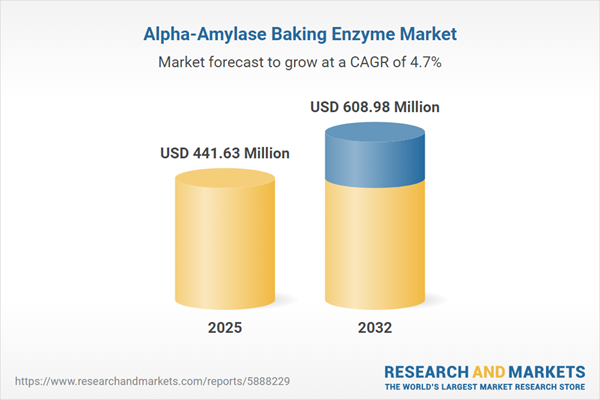Speak directly to the analyst to clarify any post sales queries you may have.
Senior executives in the alpha-amylase baking enzyme market face a landscape driven by rapid consumer, regulatory, and technology shifts. Access to precise market intelligence supports agile decision-making, risk management, and sustainable growth for organizations seeking to lead in this sector.
Market Snapshot: Alpha-Amylase Baking Enzyme Market Outlook and Growth
The alpha-amylase baking enzyme market demonstrates steady expansion, with the pace underpinned by advancements in enzyme manufacturing and evolving production standards. Growth across bakery operations, from established industrial producers to smaller artisan segments, is reshaping priorities toward scalable and efficient enzyme solutions. Market demand is rising for ingredient transparency and the adoption of clean-label baking, propelling the development and use of innovative enzyme products. Regional differences in regulatory requirements and the evolution of global supply chains are influencing deployment strategies. Continued success depends on adaptability to changing consumer trends and regulatory frameworks, as well as efficient production methods in a complex bakery environment.
Scope & Segmentation in the Alpha-Amylase Baking Enzyme Market
This report targets the specific needs of senior leaders, outlining market segments and dynamics critical to strategic planning:
- Application Categories: Solutions designed for bread, biscuits, and a range of baked goods, supporting improved shelf-life and freshness for both industrial-scale and artisan producers.
- Source Origins: Enzyme formulations derived from animal, bacterial, or fungal origins, including genetically modified strains and established legacy variants such as Aspergillus niger and Aspergillus oryzae, address operational diversity.
- Product Types: A portfolio including liquid, powder, granulated, and spray-dried enzymes, each presented in multiple concentrations to align with variable bakery workflows.
- Distribution Channels: Supply strategies incorporating direct business distribution, online commerce, and collaborative partnerships, focusing on the needs of wholesale and commercial buyers.
- Regional Coverage: Strategic focus on Americas, Europe, Middle East, Africa, and Asia-Pacific, reflecting unique regulatory environments and market-growth profiles in each region.
- Key Companies: Profiles and analysis of industry leaders such as Novozymes A/S, International Flavors & Fragrances Inc., Koninklijke DSM N.V., BASF SE, AB Enzymes GmbH, Kerry Group plc, Chr. Hansen Holding A/S, Amano Enzyme Inc., Advanced Enzyme Technologies Ltd., and Shin Nihon Chemical Co., Ltd., emphasizing evolving technological capabilities and supply chain strengths.
Key Takeaways for Senior Decision-Makers
- Integrating alpha-amylase enzymes elevates dough performance and consistency across different production models, enhancing reliability in output.
- Advanced processing and dosing solutions empower manufacturers to adjust swiftly to evolving product formulations and diverse customer expectations.
- Focusing on clean-label and transparent sourcing creates points of differentiation, supporting stronger relationships with discerning commercial clients and stakeholders.
- Strategic supply chain management—including adaptive partnerships—helps mitigate procurement volatility and ensures stability in raw material availability.
- Localized strategies and application-specific solutions present targeted growth opportunities, reinforcing competitive advantages in evolving regional markets.
- Regular monitoring of technological and market advancements prepares organizations to respond adeptly to ongoing change and secure future growth.
Tariff Impact: Cost Realignment and Supply Chain Strategy
Upcoming changes to U.S. tariffs in 2025 are anticipated to impact cost structures and supply chain approaches within the alpha-amylase baking enzyme sector. Senior leaders prioritizing localization and robust financial planning will position their organizations to manage regulatory fluctuations and withstand economic pressures more effectively.
Methodology & Data Sources
The analysis is based on direct consultations with enzyme producers, input from bakery industry leaders, and the latest global regulatory updates. Findings are validated through a careful review of recent scientific research and published industry literature, ensuring relevance and accuracy for executive planning.
Why This Report Matters in the Alpha-Amylase Baking Enzyme Market
- Guides executive teams in identifying new business opportunities and adapting swiftly to regulatory or market shifts.
- Strengthens the development of flexible, responsive supply chain strategies to maintain consistent product quality across diverse geographies.
- Supports seamless adoption of new technologies and compliance requirements, making operational improvements actionable for senior decision-makers.
Conclusion
This report equips senior leaders with actionable guidance to mitigate risk and support sustainable advancement within the alpha-amylase baking enzyme market.
Additional Product Information:
- Purchase of this report includes 1 year online access with quarterly updates.
- This report can be updated on request. Please contact our Customer Experience team using the Ask a Question widget on our website.
Table of Contents
3. Executive Summary
4. Market Overview
7. Cumulative Impact of Artificial Intelligence 2025
Companies Mentioned
The companies profiled in this Alpha-Amylase Baking Enzyme market report include:- Novozymes A/S
- International Flavors & Fragrances Inc.
- Koninklijke DSM N.V.
- BASF SE
- AB Enzymes GmbH
- Kerry Group plc
- Chr. Hansen Holding A/S
- Amano Enzyme Inc.
- Advanced Enzyme Technologies Ltd
- Shin Nihon Chemical Co., Ltd.
Table Information
| Report Attribute | Details |
|---|---|
| No. of Pages | 184 |
| Published | October 2025 |
| Forecast Period | 2025 - 2032 |
| Estimated Market Value ( USD | $ 441.63 Million |
| Forecasted Market Value ( USD | $ 608.98 Million |
| Compound Annual Growth Rate | 4.7% |
| Regions Covered | Global |
| No. of Companies Mentioned | 11 |









